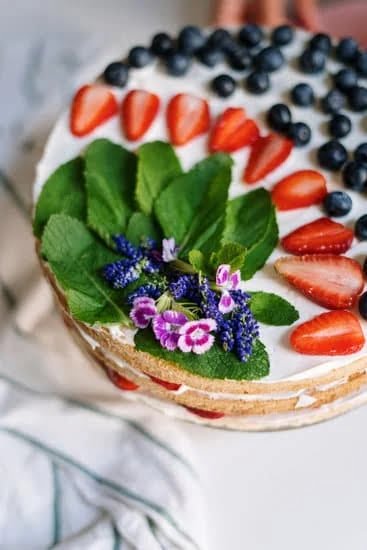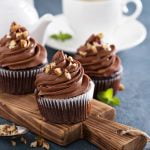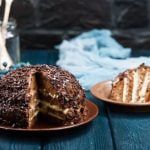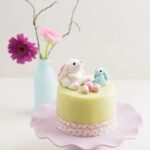Can you decorate a cake with artificial flowers? The trend of adorning cakes with beautifully crafted artificial flowers has been steadily gaining popularity in the world of cake decorating.
From weddings to birthdays, these delicate and lifelike blooms are adding a touch of elegance and charm to various cake designs. In this article, we will explore the pros and cons of using artificial flowers for cake decoration, provide tips on choosing the right flowers, offer a step-by-step guide on how to decorate a cake with artificial flowers, and much more.
Decorating cakes with artificial flowers can elevate the overall aesthetic appeal of a cake while also providing versatility in design options. However, there are certain considerations to keep in mind when using these synthetic blooms. Understanding the advantages and disadvantages will help bakers and decorators make informed decisions when incorporating artificial flowers into their creations.
Choosing the right artificial flowers for cake decoration is essential for achieving a visually stunning result. From color coordination to size and material, selecting the perfect blooms can make all the difference in enhancing the beauty of a cake. With the wide variety of artificial flowers available, it’s important to know which ones are suitable for use on edible creations and how to ensure they are safe for consumption.
The Pros and Cons of Decorating Cakes With Artificial Flowers
Decorating cakes with artificial flowers has become a popular trend in the world of baking and cake decorating. While there are certainly advantages to using artificial flowers for cake decoration, there are also some drawbacks to consider.
One of the main advantages of using artificial flowers on cakes is the convenience factor. Fresh flowers can be delicate and require special care to keep them looking their best, whereas artificial flowers will not wilt or droop, allowing you to decorate your cake in advance without worrying about the flowers wilting before your event.
On the other hand, one of the main drawbacks of using artificial flowers on cakes is that they are not edible. Some artificial flowers may be made from materials that are not safe for consumption, so it’s important to ensure that any artificial flowers used for cake decoration are specifically intended for use in food presentation.
Another potential downside to using artificial flowers is the cost. While some high-quality artificial flowers can be quite expensive, especially those made from silk or other premium materials, fresh flowers can often be more affordable, especially if you have access to a garden or affordable local florist.
Choosing the Right Artificial Flowers for Cake Decoration
When it comes to choosing the right artificial flowers for cake decoration, there are several factors to consider. From the type of flower to its size and material, it’s important to select the best artificial flowers that will enhance the overall design of the cake without compromising food safety.
Types of Artificial Flowers
There are a variety of artificial flowers available on the market, including silk, foam, paper, and plastic. Silk flowers are often favored for cake decoration due to their realistic appearance and soft texture. Foam flowers are lightweight and easy to work with, while paper flowers can add a delicate touch to the cake design. On the other hand, plastic flowers may not be as lifelike but can still be used effectively for certain cake designs.
Size and Color Considerations
When choosing artificial flowers for cake decoration, it’s important to consider the size and color of the blooms. The size of the flowers should complement the overall size of the cake and not overwhelm it. Additionally, consider whether you want a monochromatic or colorful floral arrangement on the cake to match the theme or occasion.
Material Safety
One important factor to consider when selecting artificial flowers for cake decoration is material safety. Ensure that the materials used in making the artificial flowers are non-toxic and food-safe. This is crucial as some artificial flowers may contain chemicals or dyes that are not suitable for direct contact with food. Always read product labels and opt for reputable sources when purchasing artificial flowers for use on cakes.
By considering these factors, you can decorate a cake with artificial flowers in a beautiful and safe manner that enhances the overall design of your confectionary creation.
Step-by-Step Guide to Decorating a Cake With Artificial Flowers
Decorating a cake with artificial flowers has become a popular trend in the world of baking and confectionary. Not only do artificial flowers add a beautiful and vibrant touch to cakes, but they can also be a convenient and cost-effective way to elevate your cake designs. Whether you are a professional baker or simply enjoy decorating cakes as a hobby, using artificial flowers can offer endless possibilities for creating stunning and unique cake designs.
When it comes to decorating a cake with artificial flowers, there are several steps you need to follow to ensure that the end result is both visually appealing and safe for consumption. Here is a step-by-step guide to help you successfully decorate a cake with artificial flowers:
- Step 1: Selecting the Right Artificial Flowers
- Step 2: Prepare the Cake
- Step 3: Placement of Artificial Flowers
- Step 4: Final Touches and Presentation
Choosing high-quality artificial flowers that are made from food-safe materials is crucial when it comes to decorating cakes. Be sure to select flowers that are specifically designed for use in food decoration, as these will be free from any harmful chemicals or dyes that could pose a risk to your health.
When preparing the cake for decoration, it is important to ensure that the surface of the cake is clean, smooth, and free from any crumbs or imperfections. This will provide a stable and even base for arranging the artificial flowers on top of the cake.
Once your cake is ready, carefully place the selected artificial flowers onto the surface of the cake in whatever arrangement you desire. Take your time with this step to create a visually pleasing design that complements the overall look of the cake.
Finally, adding some final touches such as edible glitter, sugar pearls, or icing details can help tie together the overall aesthetic of the cake and create a stunning presentation.
Incorporating artificial flowers into your cake designs opens up countless opportunities for creativity and innovation in your baking endeavors. With proper planning and attention to detail, using artificial flowers can add an extra element of beauty and sophistication to your cakes without compromising on taste or safety.
Tips for Using Artificial Flowers Safely on Cakes
When it comes to using artificial flowers for cake decoration, safety is a top priority. While artificial flowers can add a beautiful and unique touch to any cake, it’s important to take certain precautions to ensure that they are safe for consumption. In this section, we will explore some tips for using artificial flowers safely on cakes.
Choosing Food-Safe Artificial Flowers
When selecting artificial flowers for cake decoration, it is crucial to choose flowers that are food-safe. Look for artificial flowers specifically labeled as “food-grade” or “edible” to ensure that they are made with materials that are safe for consumption. Avoid using decorative flowers intended for craft projects or home decor, as these may contain non-edible components that can be harmful if ingested.
Using a Protective Barrier
To further ensure the safety of artificial flowers on cakes, consider using a protective barrier between the flowers and the cake itself. This can be achieved by placing a piece of parchment paper or plastic wrap between the artificial flowers and the cake surface. This not only helps to prevent any direct contact between the non-edible materials of the flowers and the cake but also makes it easier to remove them before serving.
Removing Before Serving
While artificial flowers can enhance the appearance of a cake, they should always be removed before serving. Prior to cutting and serving the cake, carefully take out all artificial flowers and any other non-edible decorations. This simple step helps to avoid any potential risk of ingestion or choking hazards associated with non-edible materials.
By following these tips, you can decorate a cake with artificial flowers in a safe and responsible manner, ensuring both beauty and safety in your creations.
Creative Ideas for Incorporating Artificial Flowers Into Cake Designs
Artificial flowers are becoming increasingly popular in cake decorating, adding a touch of elegance and beauty to any dessert. But how can you incorporate them into your cake designs? Here are some creative ideas for using artificial flowers to create stunning and unique cakes.
One creative idea is to use a cascading arrangement of artificial flowers to add drama and flair to the top or side of a tiered cake. This design creates a beautiful and eye-catching display that is sure to impress your guests. You can choose flowers in complementary colors and sizes to create a visually appealing cascade that adds depth and dimension to the cake.
Another creative way to incorporate artificial flowers into cake designs is by creating floral wreaths or garlands to adorn the edges of the cake. These delicate arrangements can be made with a variety of flower types and colors, allowing you to customize the design to fit any theme or style. Floral wreaths can be placed around the base of single-tier cakes, while garlands can be wrapped around the tiers of multi-tiered cakes for a stunning effect.
Additionally, using artificial flowers as accents on fondant or buttercream icing is another creative way to enhance your cake designs. Small clusters of artificial flowers can be strategically placed around the cake to add pops of color and texture. These accents can be used sparingly for a subtle touch or more generously for a bolder statement.
Incorporating artificial flowers into cake designs opens up endless possibilities for creativity and customization. Whether you opt for cascading arrangements, floral wreaths, garlands, or simple accents, there are countless ways to use artificial flowers to elevate your cakes from ordinary to extraordinary.
| Creative Cake Design Idea | Description |
|---|---|
| Cascading Flower Arrangements | Adding drama and flair with a visually appealing cascade |
| Floral Wreaths/Garlands | Adorning the edges of the cake with delicate arrangements in various colors |
| Accents on Fondant/Buttercream Icing | Using small clusters of artificial flowers for pops of color and texture |
Real vs Artificial Flowers
When it comes to cake decorating, the choice between using real or artificial flowers is a topic of debate among bakers and decorators. Both options have their own set of advantages and disadvantages, so it’s important to consider your specific needs and preferences when deciding which route to take.
Real flowers can provide a natural and organic aesthetic to cake designs. They offer a fragrant and visually appealing touch that can enhance the overall look of the cake. However, there are some drawbacks to using real flowers on cakes.
Firstly, not all flowers are edible, so it’s crucial to ensure that the flowers being used are safe for consumption. Additionally, real flowers can wilt over time and may contain pesticides or other chemicals that are not meant for food contact.
On the other hand, artificial flowers offer a durable and long-lasting option for cake decoration. They come in a wide variety of colors and styles, allowing for endless creativity in cake designs. Artificial flowers also eliminate the concern of potential allergens or toxins from non-edible real flowers. However, some people argue that artificial flowers lack the natural beauty and fragrance that real flowers provide.
Ultimately, whether real or artificial flowers are better for cake decoration depends on your specific needs and priorities. If you prioritize longevity and flexibility in design, artificial flowers may be the better choice for you.
On the other hand, if you value the authenticity and natural beauty that real flowers bring to cakes, then using fresh blooms may be the way to go. Regardless of your choice, it’s important to ensure that any decorations placed on a cake are safe for consumption and handled with proper care throughout the process of decorating.
The Dos and Don’ts of Decorating Cakes With Artificial Flowers
Decorating cakes with artificial flowers has become a popular trend in the world of baking and cake decorating. However, there are certain dos and don’ts that should be kept in mind when using artificial flowers to adorn your sweet creations.
One important “do” when it comes to decorating cakes with artificial flowers is to ensure that the flowers are food-safe. Not all artificial flowers are meant to come into contact with food, so it’s crucial to select blooms that are specifically labeled as edible or food-safe. This will help avoid any potential health risks for those consuming the cake.
Another essential “do” is to properly clean and prepare the artificial flowers before placing them on the cake. Even if the flowers are labeled as food-safe, they may have accumulated dust or other debris during storage. Thoroughly wash the flowers with water and a gentle detergent, then allow them to air dry completely before use.
One important “don’t” is to never directly insert artificial flowers into a cake without using a barrier. While fresh flowers can often be inserted directly into a cake, it is not safe to do so with artificial blooms.
The wire or other materials used in artificial flower stems can pose a choking hazard if accidentally consumed, so it’s crucial to first wrap the stems in floral tape or insert them into food-safe picks before placing them on the cake.
Conclusion
In conclusion, decorating cakes with artificial flowers has become a popular trend in the world of cake design. While there are both pros and cons to using artificial flowers for cake decoration, many bakers and decorators have embraced the beauty and versatility that these faux blooms can bring to their creations. From the ease of use to the endless design possibilities, artificial flowers offer a unique way to add color, texture, and style to any cake.
When choosing artificial flowers for cake decoration, it is important to consider factors such as size, color, and material. Selecting high-quality artificial flowers that are food-safe and non-toxic is essential to ensure the safety of the finished product. Additionally, following a step-by-step guide for incorporating artificial flowers into cake designs can help achieve a professional look while avoiding any potential pitfalls.
While real flowers certainly have their own appeal, using artificial flowers for cake decorating opens up a world of possibilities. The ease of handling, extended durability, and wide range of options make artificial flowers a fantastic choice for adding a touch of elegance or whimsy to any cake design.
By embracing the beauty and creative potential of artificial flowers in cake decorating, bakers and decorators can elevate their creations to new heights. So yes, you can definitely decorate a cake with artificial flowers – and with stunning results.
Frequently Asked Questions
How Do You Put Fake Flowers on a Cake?
Fake flowers can be placed on a cake by ensuring they are clean and food-safe. Some methods include inserting them into a plastic straw before placing them on the cake or using floral tape to cover non-edible stems.
What Type of Flowers Are Safe to Put on a Cake?
When choosing flowers to put on a cake, it’s important to consider their safety. Opt for edible flowers like roses, violets, or lavender. It’s crucial to ensure that the flowers have not been treated with chemicals.
Is It OK to Decorate With Fake Flowers?
Decorating with fake flowers is generally okay as long as certain precautions are taken. If using artificial flowers on a cake, make sure they are completely clean and have not been in contact with any harmful substances. Be aware of any potential allergies when considering artificial decorations.

Welcome to our cake decorating blog! My name is Destiny Flores, and I am the proud owner of a cake decorating business named Cake Karma. Our mission is to provide delicious, beautiful cakes for all occasions. We specialize in creating custom cakes that are tailored specifically to each customer’s individual needs and tastes.





